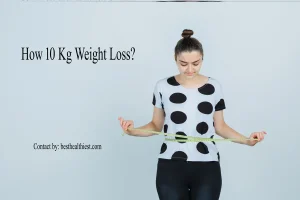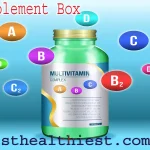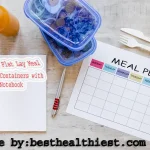Achieving a 10 kg weight loss in just 7 days requires a strict diet plan focused on calorie deficit and nutrient-dense foods. Incorporating regular exercise and hydration will enhance results significantly.
Weight loss can feel daunting, especially with ambitious goals like shedding 10 kg in a week. It’s crucial to focus on whole foods, reducing processed items, and maintaining a balanced nutrient intake.
Combining this with regular exercise can amplify your results. Staying hydrated and prioritizing sleep also play vital roles in supporting your metabolism and overall health. This guide will outline an effective 7-day diet plan, helping you achieve your weight loss goals while ensuring your body receives necessary nutrients.
Introduction To Rapid Weight Loss
Rapid weight loss can be appealing for many. A 10 kg weight loss in just 7 days sounds incredible. It promises quick results and a fresh start. This type of diet plan requires commitment and focus. Understanding the right approach is essential for success.
Motivations And Expectations
People have various reasons for wanting to lose weight quickly. Common motivations include:
- Upcoming events like weddings or vacations
- Health improvements
- Boosting self-esteem and confidence
It’s vital to set realistic expectations. 10 kg in 7 days is a dramatic loss. Weight loss is influenced by numerous variables, including:
- Body composition
- Metabolism rate
- Activity level
Expect fluctuations in weight. Rapid loss may not be sustainable. Focus on long-term health over quick fixes.
Health Considerations Before Starting

Before starting a rapid weight loss plan, consider your health. Consult a healthcare professional. Some important health considerations include:
- Pre-existing medical conditions
- Nutrition needs
- Physical activity levels
Rapid weight loss can lead to:
| Potential Risks | Description |
| Nutrient Deficiencies | Not getting enough vitamins and minerals. |
| Muscle Loss | Losing muscle instead of fat. |
| Fatigue | Feeling tired and low on energy. |
Understanding these risks helps you make informed decisions. Weight loss should promote health, not harm.
The Science Behind Quick Weight Loss
Understanding how quick weight loss works is crucial for success. Yet, it revolves around a few scientific principles. This section explores the core concepts behind rapid weight loss.
Understanding Caloric Deficit
When you burn more calories than you take in, you have a caloric deficit. Because of this shortfall, the body must use its fat reserves as fuel. Here’s how it works:
- Calculate daily calorie needs.
- Cut your daily caloric intake by 500–1000 calories.
- This can lead to a loss of 0.5 to 1 kg per week.
| Caloric Intake | Caloric Burn | Deficit |
| 1500 calories | 2000 calories | 500 calories |
| 1200 calories | 2200 calories | 1000 calories |
Creating a caloric deficit is key. Balanced meals and exercise enhance this process. Steer clear of processed foods and concentrate on whole foods.
Role Of Metabolism In Weight Loss
The process of turning food into energy is called metabolism. A quicker metabolism facilitates more effective calorie burning. Here are factors that influence metabolism:
- Age: Metabolism slows down with age.
- Muscle Mass: More muscle burns more calories.
- Activity Level: Regular exercise boosts metabolism.
To enhance metabolism:
- Incorporate strength training.
- Stay hydrated.
- Get enough sleep.
Understanding these concepts can help achieve rapid weight loss safely. Focus on maintaining a caloric deficit while boosting your metabolism.
Creating Your 7-day Diet Plan
Creating a 7-day diet plan is crucial if you want to lose 10 kg. This plan helps you stay organized and committed. Focus on healthy foods and balanced meals. You can achieve your goals with careful planning.
Meal Planning Basics
Start by understanding meal planning. It helps you control what you eat. Follow these simple steps:
- Set Caloric Goals: Aim for a daily deficit of 500-1000 calories.
- Include All Food Groups: Ensure protein, carbs, and healthy fats.
- Portion Control: To prevent overindulging, use smaller dishes.
- Drink two liters or more of water each day to stay hydrated.
Here’s a sample meal layout for the week:
| Day | Breakfast | Lunch | Dinner |
| Monday | Oatmeal with fruits | Grilled chicken salad | Steamed veggies with fish |
| Tuesday | Smoothie with spinach | Quinoa and beans | Stir-fried tofu and broccoli |
| Wednesday | Greek yogurt with nuts | Lentil soup | Grilled shrimp with asparagus |
| Thursday | Scrambled eggs and tomatoes | Turkey wrap | Zucchini noodles with marinara |
| Friday | Fruit salad | Chickpea salad | Baked chicken with sweet potatoes |
| Saturday | Pancakes with berries | Cauliflower rice bowl | Beef stir-fry with peppers |
| Sunday | Avocado toast | Mixed greens with tuna | Vegetable curry with brown rice |
Grocery Shopping List
A well-planned grocery list saves time and money. Here’s a list to help you:
- Fruits: Apples, bananas, berries, oranges
- Vegetables: Spinach, broccoli, carrots, zucchini
- Proteins: Chicken, fish, tofu, eggs
- Whole Grains: Quinoa, brown rice, oats
- Healthy Fats: Avocado, nuts, olive oil
- Snacks: Greek yogurt, hummus, popcorn
Check your pantry before shopping. This prevents buying unnecessary items. Stick to your list for better results.

Daily Meal Breakdown
This 7-day diet plan will help you lose 10 kg. Each day focuses on specific foods and meals. Follow the breakdown for effective weight loss.
Day 1: Kickstarting Your Diet
Start your journey with a clean slate. Focus on hydration and light meals.
- Smoothie with banana, almond milk, and spinach for breakfast.
- Lunch would be quinoa salad with olive oil, tomatoes, and cucumber.
- Dinner: Grilled chicken with steamed broccoli and carrots.
- Snacks: Almonds and an apple.
Day 2: Metabolism Boosting Foods
Incorporate foods that boost your metabolism. Enjoy spicy flavors.
- Breakfast: Oatmeal with cinnamon and berries.
- Lunch: Chickpea salad with lemon and chili.
- Dinner: Baked salmon with asparagus and garlic.
- Snacks: Carrot sticks with hummus.
Day 3: Plant-based Focus
Switch to plant-based meals for a day. Increase fiber intake.
- Breakfast: Chia seed pudding with coconut milk.
- Lunch: Lentil soup with mixed vegetables.
- Dinner: Stir-fried tofu with bell peppers and broccoli.
- Snacks: Celery sticks with peanut butter.
Day 4: Protein-packed Meals
Protein helps build muscle and burn fat. Focus on lean sources.
- Breakfast: Scrambled eggs with spinach and tomatoes.
- Lunch: Turkey wrap with lettuce and avocado.
- Dinner: Grilled shrimp with quinoa and green beans.
- Snacks: Greek yogurt with honey.
Day 5: Fat Burning Accelerators
Choose foods that accelerate fat burning. Opt for healthy fats.
- Breakfast is a protein powder, spinach, and avocado smoothie.
- Lunch: Chicken salad with walnuts and vinaigrette.
- Dinner: Beef stir-fry with broccoli and sesame seeds.
- Snacks: Mixed nuts and berries.
Day 6: Combining Macros Effectively
Balance protein, carbs, and fats for optimal results. Keep portions in check.
- Breakfast consists of avocado, eggs, and whole grain toast.
- Lunch: Quinoa bowl with black beans and corn.
- Dinner: Grilled chicken with sweet potato and spinach.
- Snacks: Cottage cheese with pineapple.
Day 7: Preparing For Post-diet Maintenance
Reflect on your journey. Plan for maintaining your weight.
- Breakfast: Smoothie with mixed fruits and spinach.
- Lunch: Salad with chickpeas, cucumbers, and feta cheese.
- Supper will include quinoa, steamed veggies, and baked salmon.
- Snacks: Dark chocolate and nuts.
Incorporating Exercise
Incorporating exercise is crucial for effective weight loss. It boosts metabolism and burns calories. A balanced approach combines diet and workouts. This helps achieve your weight loss goal faster.
Balancing Exercise With Diet
Balancing exercise with diet is essential for weight loss. Eating the right foods fuels your workouts. Here are some tips:
| Meal Type | Best Foods |
| Breakfast | Oatmeal, fruits, and yogurt |
| Lunch | Grilled chicken, salad, and quinoa |
| Dinner | Fish, steamed veggies, and brown rice |
| Snacks | Nuts, seeds, and fresh fruits |
Stay hydrated throughout the day. Hydrate well both before and after working exercise. This promotes general health and healing.
Hydration And Its Role In Weight Loss
Staying hydrated is key for successful weight loss. Water helps your body function properly. It aids in digestion and boosts metabolism. Drinking enough water can suppress your appetite. This facilitates following a diet plan.
Hydration also improves energy levels. This encourages more physical activity. Increased activity burns more calories. Overall, hydration plays a crucial role in your weight loss journey.
Water Intake Recommendations
Follow these simple guidelines for daily water intake:
| Age Group | Daily Water Intake (Liters) |
| Children (4-8 years) | 1.2 L |
| Teens (9-18 years) | 1.5-2 L |
| Adults | 2-3 L |
Listen to your body. Drink water when you feel thirsty. During hot weather or vigorous exercise, increase consumption.
Detox Water Recipes
Detox water is refreshing and promotes hydration. Try these easy recipes:
- Cucumber Mint Water
- 1 cucumber, sliced
- 1 handful of mint leaves
- 2 liters of water
- Lemon Ginger Water
- 1 lemon, sliced
- 1-inch ginger, sliced
- 2 liters of water
- Berry Citrus Water
- 1 cup mixed berries
- 1 orange, sliced
- 2 liters of water
Make these detox waters the night before. Allow them to infuse overnight. Enjoy them throughout the day. These recipes keep hydration interesting and tasty.
Managing Hunger And Cravings
Managing hunger and cravings is crucial for a successful weight loss journey. Following a strict diet can make you feel deprived. Knowing how to handle these feelings helps you stay on track. Effective strategies can reduce cravings and keep you satisfied.
Healthy Snacking Options
Choosing the right snacks can curb hunger between meals. Opt for snacks that are nutritious and filling. Here are some healthy snacking options:
- Fruits: Apples, bananas, and berries are great choices.
- Vegetables: bell peppers, cucumber slices, and carrot sticks.
- Nuts: Almonds and walnuts in moderation.
- Yogurt: Low-fat yogurt is rich in protein.
- Popcorn: Air-popped popcorn is low in calories.
These snacks can help keep cravings at bay. They provide essential nutrients and fiber. This makes you feel full longer.
Mindful Eating Techniques
Mindful eating can transform your relationship with food. Being present throughout meals is the main goal of this practice. Try these mindful eating techniques:
- Slow Down: Chew each bite thoroughly. Enjoy the flavors.
- Listen to Your Body: Eat when you’re hungry, stop when full.
- Limit Distractions: Avoid screens and focus on your meal.
- Portion Control: Use smaller plates to serve food.
- Stay Hydrated: Drink water before meals to curb hunger.
These techniques encourage awareness around food choices. They help control portions and reduce overeating. Managing hunger and cravings leads to better weight loss results.
Monitoring Your Progress
Tracking your weight loss is essential. It helps you stay motivated. Seeing results boosts your confidence. Use tools to make this easier.
Tracking Weight Loss
Start by weighing yourself regularly. Use the same scale each time. Take your own weight at the same time of day. This ensures consistency.
Record your weight in a journal or app. This helps visualize your progress. Here’s a simple table format you can use:
| Date | Weight (kg) |
| Day 1 | Initial Weight |
| Day 2 | Weight |
| Day 3 | Weight |
| Day 4 | Weight |
| Day 5 | Weight |
| Day 6 | Weight |
| Day 7 | Weight |
Take body measurements too. Measure your waist, hips, and thighs. Record these numbers weekly. Changes here show progress beyond weight.
Adjusting The Diet Plan For Results
Your diet plan may need tweaks. If weight loss stalls, reassess your meals. Here are some steps to adjust:
- Review your calorie intake.
- Increase protein in your meals.
- Cut down on sugary snacks.
- Stay hydrated with water.
- Consider meal timing and frequency.
Track how these changes affect your weight. Make small adjustments weekly. This helps find the best plan for you.
Celebrate your milestones. Reward yourself for hitting targets. This keeps you engaged and motivated.
Potential Risks And How To Mitigate Them
A rapid weight loss plan can offer quick results. However, it also poses potential risks. Understanding these risks helps in making informed choices. Knowing how to mitigate them is essential for safe weight loss.
Common Side Effects
Following a strict diet for quick weight loss can lead to several side effects. Here are some common issues:
- Fatigue: Low energy levels due to reduced calorie intake.
- Dizziness: Lack of nutrients can cause light-headedness.
- Headaches: Withdrawal from caffeine or sugar can trigger pain.
- Muscle Loss: Rapid weight loss may lead to losing muscle mass.
- Digestive Issues: Sudden dietary changes can upset the stomach.
To minimize these side effects:
- Stay hydrated by drinking plenty of water.
- Include small, balanced meals throughout the day.
- Incorporate vitamins or supplements as needed.
When To Consult A Professional
Consulting a healthcare professional is crucial in certain situations:
- Experiencing severe side effects like fainting or extreme fatigue.
- Having pre-existing health conditions, such as diabetes or heart issues.
- Feeling unwell or unable to continue the diet.
Getting expert advice ensures safety and health during your weight loss journey. Your health should always come before immediate success.
Sustaining Weight Loss Post-diet
Following a fast diet, maintaining weight reduction is essential. Many lose weight quickly but struggle to keep it off. A solid plan helps maintain results and promotes overall health.
Transitioning To A Long-term Healthy Diet
Transitioning is vital after your 7-day diet plan. Gradually reintroduce foods to avoid weight regain. Here are some key steps:
- Include whole foods: Focus on fruits, vegetables, and whole grains.
- Watch portion sizes: Control portions to manage caloric intake.
- Reduce your intake of processed foods: Cut back on sweets and bad fats..
- Stay hydrated: Drink plenty of water daily.
Plan meals ahead to ensure healthy choices. Use this table for a sample meal transition:
| Day | Breakfast | Lunch | Dinner |
| 1 | Oatmeal with berries | Grilled chicken salad | Steamed veggies with fish |
| 2 | Smoothie with spinach | Quinoa with vegetables | Turkey with sweet potatoes |
| 3 | Eggs with avocado | Lentil soup | Stir-fried tofu with broccoli |
Lifestyle Changes For Lasting Weight Management
Making lifestyle changes helps maintain weight loss. Here are effective strategies:
- Engage in regular exercise: Try to get in at least 30 minutes each day.
- Track your meals: Use an app or journal.
- Set realistic goals: Focus on gradual, healthy changes.
- Make sure you get 7-8 hours of sleep every night.
- Stay accountable: Join a support group or find a buddy.
These changes create a balanced lifestyle. Enjoying the journey makes it easier to maintain weight loss.
Conclusion
Achieving a 10 kg weight loss in just seven days is ambitious but possible with the right diet plan. Focus on balanced meals, hydration, and regular exercise. Keep in mind that long-term lifestyle adjustments produce sustainable outcomes. Always consult a healthcare professional before starting any extreme diet.
Your journey to health starts today!










